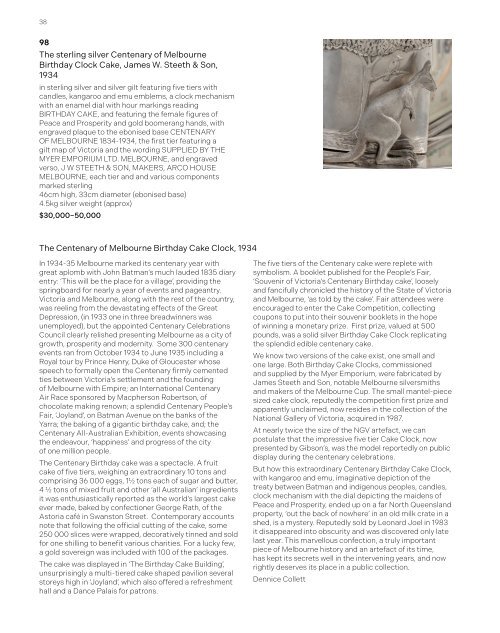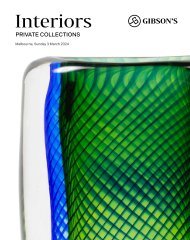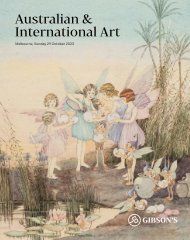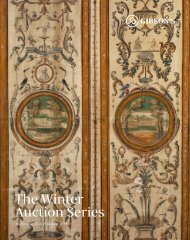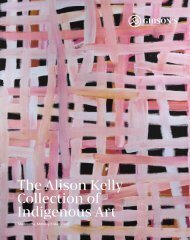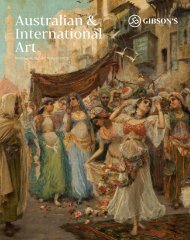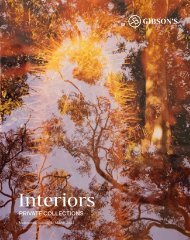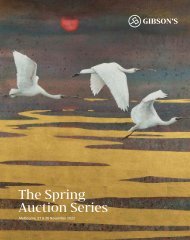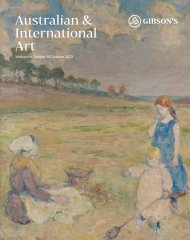GA047-cat-flipbook-v1
ibson’s is delighted to announce our forthcoming Australian, Maritime & Exploration auction featuring items of Australian historical interest and importance including Australian and Colonial Furniture, Decorative Arts, Paintings and Early Photography, Scrimshaw, Artefacts, Goldfields and Convict interest, Militaria, Books and Documents. Leading the sale is the exquisite Australian silver cake clock, commissioned by the Myer Emporium in celebration of the Centenary of Melbourne in 1934, made by renowned silversmiths, Steeth & Son, of Melbourne Cup fame. At almost five kilograms of silver, this example is twice the size of the model in the collection of the National Gallery of Victoria and presents a unique opportunity for private collectors and institutions to acquire a piece of significant Victorian history.
ibson’s is delighted to announce our forthcoming Australian, Maritime & Exploration auction featuring items of Australian historical interest and importance including Australian and Colonial Furniture, Decorative Arts, Paintings and Early Photography, Scrimshaw, Artefacts, Goldfields and Convict interest, Militaria, Books and Documents.
Leading the sale is the exquisite Australian silver cake clock, commissioned by the Myer Emporium in celebration of the Centenary of Melbourne in 1934, made by renowned silversmiths, Steeth & Son, of Melbourne Cup fame. At almost five kilograms of silver, this example is twice the size of the model in the collection of the National Gallery of Victoria and presents a unique opportunity for private collectors and institutions to acquire a piece of significant Victorian history.
Create successful ePaper yourself
Turn your PDF publications into a flip-book with our unique Google optimized e-Paper software.
38<br />
98<br />
The sterling silver Centenary of Melbourne<br />
Birthday Clock Cake, James W. Steeth & Son,<br />
1934<br />
in sterling silver and silver gilt featuring five tiers with<br />
candles, kangaroo and emu emblems, a clock mechanism<br />
with an enamel dial with hour markings reading<br />
BIRTHDAY CAKE, and featuring the female figures of<br />
Peace and Prosperity and gold boomerang hands, with<br />
engraved plaque to the ebonised base CENTENARY<br />
OF MELBOURNE 1834-1934, the first tier featuring a<br />
gilt map of Victoria and the wording SUPPLIED BY THE<br />
MYER EMPORIUM LTD. MELBOURNE, and engraved<br />
verso, J W STEETH & SON, MAKERS, ARCO HOUSE<br />
MELBOURNE, each tier and and various components<br />
marked sterling<br />
46cm high, 33cm diameter (ebonised base)<br />
4.5kg silver weight (approx)<br />
$30,000–50,000<br />
The Centenary of Melbourne Birthday Cake Clock, 1934<br />
In 1934-35 Melbourne marked its centenary year with<br />
great aplomb with John Batman’s much lauded 1835 diary<br />
entry: ‘This will be the place for a village’, providing the<br />
springboard for nearly a year of events and pageantry.<br />
Victoria and Melbourne, along with the rest of the country,<br />
was reeling from the devastating effects of the Great<br />
Depression, (in 1933 one in three breadwinners was<br />
unemployed), but the appointed Centenary Celebrations<br />
Council clearly relished presenting Melbourne as a city of<br />
growth, prosperity and modernity. Some 300 centenary<br />
events ran from October 1934 to June 1935 including a<br />
Royal tour by Prince Henry, Duke of Gloucester whose<br />
speech to formally open the Centenary firmly cemented<br />
ties between Victoria’s settlement and the founding<br />
of Melbourne with Empire; an International Centenary<br />
Air Race sponsored by Macpherson Robertson, of<br />
chocolate making renown; a splendid Centenary People’s<br />
Fair, ‘Joyland’, on Batman Avenue on the banks of the<br />
Yarra; the baking of a gigantic birthday cake, and; the<br />
Centenary All-Australian Exhibition, events showcasing<br />
the endeavour, ‘happiness’ and progress of the city<br />
of one million people.<br />
The Centenary Birthday cake was a spectacle. A fruit<br />
cake of five tiers, weighing an extraordinary 10 tons and<br />
comprising 36 000 eggs, 1½ tons each of sugar and butter,<br />
4 ½ tons of mixed fruit and other ‘all Australian’ ingredients<br />
it was enthusiastically reported as the world’s largest cake<br />
ever made, baked by confectioner George Rath, of the<br />
Astoria café in Swanston Street. Contemporary accounts<br />
note that following the official cutting of the cake, some<br />
250 000 slices were wrapped, decoratively tinned and sold<br />
for one shilling to benefit various charities. For a lucky few,<br />
a gold sovereign was included with 100 of the packages.<br />
The cake was displayed in ‘The Birthday Cake Building’,<br />
unsurprisingly a multi-tiered cake shaped pavilion several<br />
storeys high in ‘Joyland’, which also offered a refreshment<br />
hall and a Dance Palais for patrons.<br />
The five tiers of the Centenary cake were replete with<br />
symbolism. A booklet published for the People’s Fair,<br />
‘Souvenir of Victoria’s Centenary Birthday cake’, loosely<br />
and fancifully chronicled the history of the State of Victoria<br />
and Melbourne, ‘as told by the cake’. Fair attendees were<br />
encouraged to enter the Cake Competition, collecting<br />
coupons to put into their souvenir booklets in the hope<br />
of winning a monetary prize. First prize, valued at 500<br />
pounds, was a solid silver Birthday Cake Clock repli<strong>cat</strong>ing<br />
the splendid edible centenary cake.<br />
We know two versions of the cake exist, one small and<br />
one large. Both Birthday Cake Clocks, commissioned<br />
and supplied by the Myer Emporium, were fabri<strong>cat</strong>ed by<br />
James Steeth and Son, notable Melbourne silversmiths<br />
and makers of the Melbourne Cup. The small mantel-piece<br />
sized cake clock, reputedly the competition first prize and<br />
apparently unclaimed, now resides in the collection of the<br />
National Gallery of Victoria, acquired in 1987.<br />
At nearly twice the size of the NGV artefact, we can<br />
postulate that the impressive five tier Cake Clock, now<br />
presented by Gibson’s, was the model reportedly on public<br />
display during the centenary celebrations.<br />
But how this extraordinary Centenary Birthday Cake Clock,<br />
with kangaroo and emu, imaginative depiction of the<br />
treaty between Batman and indigenous peoples, candles,<br />
clock mechanism with the dial depicting the maidens of<br />
Peace and Prosperity, ended up on a far North Queensland<br />
property, ‘out the back of nowhere’ in an old milk crate in a<br />
shed, is a mystery. Reputedly sold by Leonard Joel in 1983<br />
it disappeared into obscurity and was discovered only late<br />
last year. This marvellous confection, a truly important<br />
piece of Melbourne history and an artefact of its time,<br />
has kept its secrets well in the intervening years, and now<br />
rightly deserves its place in a public collection.<br />
Dennice Collett


